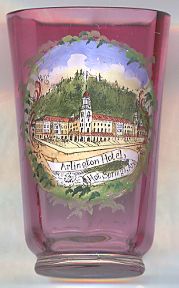

|
| UNITED STATES OF AMERICA | |
| ARKANSAS | |
| Garland County |
 Hot Springs is the county seat of Garland County, and the principal city of the Hot Springs Metropolitan Statistical Area
encompassing all of Garland County. According to 2005 Census Bureau estimates, the population of the city was 37,847.
Hot Springs is the county seat of Garland County, and the principal city of the Hot Springs Metropolitan Statistical Area
encompassing all of Garland County. According to 2005 Census Bureau estimates, the population of the city was 37,847.
Hot Springs is traditionally best known for the natural spring water that gives it its name, flowing out of the ground at a temperature of 147°F (64°C). Hot Springs National Park is the oldest federal reserve in the USA, and the tourist trade brought by the famous springs make it a very successful spa town. The city takes its name from the natural thermal water that flows from 47 springs on the western slope of Hot Springs Mountain in the historic downtown district of the city. About a million gallons of water flow from the springs each day. The rate of flow is not affected by fluctuations in the rainfall in the area. Studies by National Park Service scientists have determined through carbon dating that the water that reaches the surface in Hot Springs fell as rainfall in an as-yet undetermined watershed 4,000 years earlier. The water percolates very slowly down through the earth’s surface until it reaches superheated areas deep in the crust and then rushes rapidly to the surface to emerge from the hot springs.
In 1673, Father Marquette and Louis Joliet explored the area and claimed it for France. The Treaty of Paris 1763 ceded the land back to Spain; however, in 1800 control was returned to France until the Louisiana Purchase of 1803. On August 24, 1818, the Quapaw Indians ceded the land around the hot springs to the United States in a treaty. After Arkansas became its own territory in 1819, the Arkansas Territorial Legislature requested in 1820 that the springs and adjoining mountains be set aside as a federal reservation. Twelve years later, in 1832, the Hot Springs Reservation was created by the US Congress, granting federal protection of the thermal waters. The Reservation was renamed Hot Springs National Park in 1921. The outbreak of the Civil War left Hot Springs with a declining bathing population. In September 1863, Union forces occupied Little Rock. During this period, Hot Springs became the prey of guerrilla bands loosely associated with either Union or Confederate forces. After the Civil War, an extensive rebuilding of bathhouses and hotels took place at Hot Springs. The year-round population soared to 1,200 inhabitants by 1870. By 1873 six bathhouses and 24 hotels and boardinghouses stood near the springs. In 1874, Joseph Reynolds announced his decision to construct a narrow gauge railroad from Malvern to Hot Springs; completion in 1875 resulted in the growth of visitation to the springs. During the Reconstruction period, several conflicting land claims reached the U.S. Congress and resulted in an April 24, 1876 United States Supreme Court ruling that the land title of Hot Springs belonged to the federal government. The commission surveyed and set aside 264.93 acres (1.0721 km²) encompassing the hot springs and Hot Springs Mountain to be a permanent government reservation. Another 1,200 acres (4.9 km²) became the Hot Springs townsite, with 700 acres (2.8 km²) awarded to claimants. Illegal gambling became firmly established in Hot Springs during the decades following the Civil War, and Hot Springs eventually became a national gambling mecca. Gambling was finally closed down permanently in 1967. [Text adapted from http://en.wikipedia.org/wiki/Hot_Springs,_Arkansas]
The picture on glass no. 2448 shows the (second)  Arlington
Arlington
![[scale]](lineal.jpg)